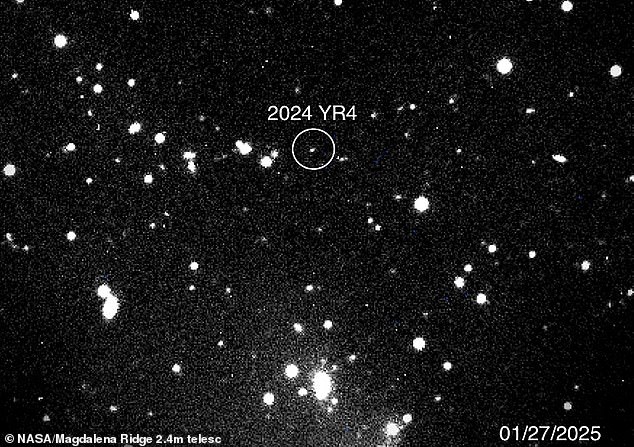Scientists have issued a chilling update on the ‘city-killer’ asteroid heading towards the moon.
Asteroid 2024 YR4, a 220-foot (67m) ‘city-killer’, currently has a four per cent chance of hitting the moon on 22 December 2032.
However, fresh observations could mean the odds of a collision rise to as high as 30 per cent.
If the massive asteroid does hit the moon, it could carve out a 0.6-mile-wide crater and shower Earth with lunar shrapnel.
Researchers predict there will be a slim window for the James Webb Space Telescope (JWST) to observe the asteroid in February.
This will be one of the last good chances to predict 2024 YR4’s trajectory before it returns into view of Earth’s telescopes in 2028.
And, according to Dr Andrew Rivkin, of Johns Hopkins University, these observations could significantly change the odds of a lunar impact.
That means the world’s space agencies are rapidly running out of time to decide what they should do.

2024 YR4 (pictured) was spotted in December 2024 and set alarm bells ringing as it reached the highest chances of hitting Earth of any known asteroid. Now, experts are concerned that it will hit the moon
2024 YR4 was spotted in December 2024 and set alarm bells ringing as it reached the highest chances of hitting Earth of any known asteroid.
At its peak, there was a terrifying one in 32 chance of the deadly space rock colliding with our planet.
Although this probability rapidly dropped to almost zero as astronomers made more observations, another troubling scenario soon presented itself.
Based on the asteroid’s predicted orbit, there was still a non-negligible chance that it would hit the moon instead.
The asteroid has been hidden from Earth’s telescopes since the middle of last year, making it difficult to predict its exact orbit.
However, the JWST’s unique position in orbit means that it will be able to see the 2024 YR4 for two brief windows on February 18 and 26.
Since the asteroid is so far away, it will still be difficult to get lots of data, but these observations could change our understanding of its position and speed.
Dr Rivkin and his colleagues have calculated how checking on the asteroid in February might change the predicted probability of a lunar impact.

The James Webb Space Telescope (JWST) will have another chance to observe 2024 YR4 in February, but these measurements could significantly change what we know about its position and velocity. Pictured: 2024 YR4 as seen by the JWST on 8 March, 2025
They predict there is an 80 per cent chance that new observations will reduce the odds of 2024 YR4 hitting the moon to below one per cent.
However, there is a five per cent chance that these observations actually increase the chances of the asteroid hitting the moon to 30 per cent.
There is also a 15 per cent chance that the odds of an impact will stay the same or only change slightly
This is extremely important because agencies like NASA and the European Space Agency are running out of time to decide whether they should deflect 2024 YR4.
NASA’s DART mission has shown that slamming a satellite into the side of an asteroid can knock it off its path by a wide enough margin to protect Earth and the moon.
But these ‘kinetic impact’ deflection methods only cause small changes in the space rock’s trajectory and need to be started years before a collision is likely.
NASA researchers have considered deflection methods for 2024 YR4, including hitting it with a nuclear bomb, but these all need to be launched by 2030 at the very latest.
The JWST will get another chance to observe 2024 YR4 in 2027, but the sooner space agencies make up their mind, the better.

If the asteroid does hit the moon, it could release 10,000 tonnes of debris into space, up to 30 per cent of which could be funnelled towards Earth (illustrated)
Dr Rivkin told New Scientist: ‘By 2028, it would be cutting things very, very close, and so getting it in early 2026 instead gives some extra time.’
Although it won’t be as destructive as an impact with the Earth, a lunar collision is dangerous enough for deflecting 2024 YR4 to be an option worth considering.
The asteroid could hit the moon at over 29,000mph (46,800 kmph), releasing a blast 500 times larger than the atomic bomb dropped on Hiroshima and ejecting 10,000 tonnes of rock into space.
If the asteroid hits in the right place, Earth’s gravity might funnel between 10 and 30 per cent of the ejected material directly towards our planet.
This could have a devastating effect on satellites in low-Earth orbit that are responsible for maintaining communications and navigation services on Earth.
Richard Moissl, head of planetary defence at ESA, told Daily Mail that a lunar collision poses no risk for people on Earth, but ‘could pose a potential threat for space-based infrastructure’.
However, there are no missions to surveil or deflect 2024 YR4 in the agency’s budget for this year.
Mr Moissl says that the decision will ‘depend on the exact situation following the observations and assessment of the situation…more detailed studies would be needed to reach a comprehensive assessment.’
